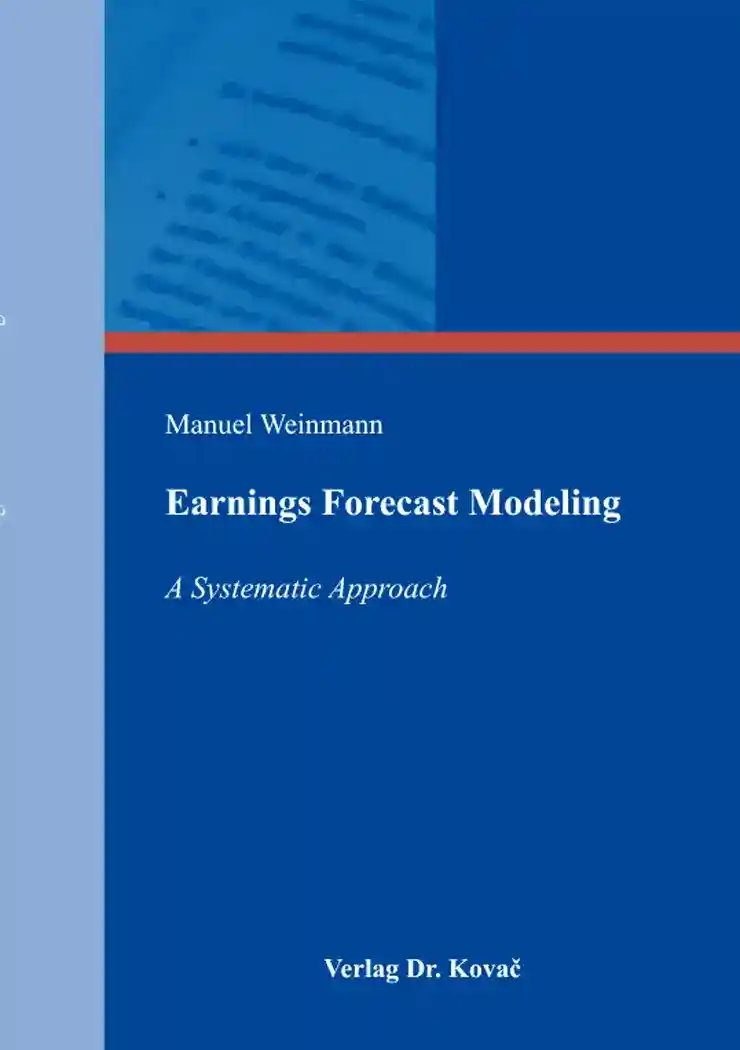Manuel WeinmannEarnings Forecast Modeling
A Systematic Approach
Finanzmanagement, Band 108
Hamburg 2014, 142 Seiten
ISBN 978-3-8300-8087-9 (Print)
ISBN 978-3-339-08087-5 (eBook)
Zum Inhalt
Equity analysts’ earnings forecasts, collected by the Institutional Brokers’ Estimate Service (IBES), Zacks and other news providers, serve as a central input in financial research. For example, Claus & Thomas (2001) use earnings forecasts to estimate the equity risk premium. The equity risk premium, defined as the excess of the expected return on the market over the risk-free rate, is most commonly estimated via historical averages of ex post realized returns due to the unobservable character of the return expectations. However, in a new approach, they estimate the expected return of a security as the internal rate of return, which equates the stock price to the present value of expected future cash flows. Using analysts’ forecasts as a proxy for expected future cash flows, Claus & Thomas (2001) present that this forward-looking approach is a much better approximation.
Courteau et al. (2001), among others, use analysts’ estimates to analyze models of the fair value of companies. In particular, they investigate whether discounted cash flow (DCF) and residual income models (RIM) are equivalent, as predicted by Penman’s (1997) theory of “ideal? terminal value expressions. They find empirical evidence that there in fact prevails an equivalence of DCF and RIM models for finite horizons under ideal conditions. Furthermore, Clement & Tse (2003) use earnings forecasts to analyze whether investors efficiently process information about analysts’ characteristics in order to evaluate the expected accuracy of an equity analyst. The authors find evidence that investors fail to extract such information related to accuracy and that they rather rely on more direct observable aspects like the size of the broker firm which employs the analyst.
However, analysts’ earnings forecasts have come under scrutiny as several behavioral biases have been detected. For example, Richardson et al. (2004) show that analysts’ forecasts tend to be overly optimistic at the beginning of a fiscal year and are revised downward during the year to arrive at a level where companies can easily beat earnings forecasts. Moreover, analyst data are available only for a fraction of the stock universe. On the one hand, coverage is in particular limited for small firms (see Diether et al. (2002)). This is insofar problematic as it results in lower private information acquisition about these firms (see Bhushan (1989)). Hong et al. (2000) show that heterogenous information flow can cause efficiency losses in pricing. On the other hand, La Porta (1996) states that also financially distressed firms are underrepresented in the IBES sample. In addition, earnings forecasts beyond the second year or long-term forecasts are unavailable for many firms (see Hou et al. (2012)). To overcome these issues, Hou et al. (2012) propose a new approach using “forecasts generated by a cross sectional model instead of analysts’ forecasts to proxy for cash flow expectations (Hou et al. (2012), p. 505). They find that their mechanical model’s earnings forecasts are on average less accurate but much less biased than analysts’ forecasts.
The goal of the author is to take a closer look at the proposed mechanical forecast model of Hou et al. (2012) and examine the accuracy and especially the forecast bias more carefully. As a result, the finding that their mechanical forecasts are more or less unbiased on average can be confirmed. However, one main contribution of this thesis to present research is the detection of a systematic bias pattern when grouping the sample by earnings quintiles. In particular, it is shown that firms with low earnings are systematically overestimated while firms with large earnings are underestimated, indicating a misspecification of the model. A further benefit of the following thesis is the analysis of behavioral patterns in the development of firms over time. These systematic tendencies are captured in a new model via methodological modifications in order to significantly improve the forecasts in terms of bias. Moreover, a hypothetical model, which is able to perfectly predict firm transitions between the earnings quintiles, is the foundation of the third important contribution: the recognition of a connection between forecast errors and non-recurring balance sheet items. This problem is so fundamental that it can be generalized to a criticism on mechanical forecast models per se.
